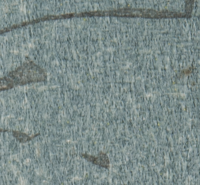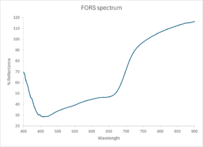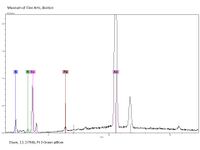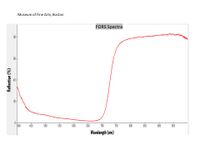Indigo/Orpiment: Ukiyo-e colorant
Indigo + Orpiment: Green is achieved by mixing or overprinting a blue and a yellow colorant. The dominant formulation for green after the development of full-color printing in the mid-1700s was a mixture of indigo and orpiment. By altering the proportions of each, a wide variation of greens could be obtained. The preference for this formulation of green may have been due to the relative stability of both indigo and orpiment to moisture. However, like most of the colorants used for woodblock printing during the Edo period, both will fade upon prolonged exposure to light.
For additional information see: Indigo, Orpiment
Examples of Indigo + Orpiment in Ukiyo-e Prints

|

|

|

|

|

|
Analysis
Fiber optic reflectance spectroscopy (FORS) is used to identify indigo and X-ray fluorescence analysis (XRF) is used to detect arsenic (As) and sulfur (S), which is an indication of the presence of orpiment (As2S3). For more information, please see the individual colorant pages, indigo and orpiment.
List of Prints
Below is a list of prints where indigo + orpiment was detected.
Pages in category "Indigo/Orpiment: Ukiyo-e colorant"
The following 58 pages are in this category, out of 58 total.
E
- Eisen, Fujieda: Kichô of the Owariya, from the series A Tôkaidô Board Game of Courtesans: Fifty-three Pairings in the Yoshiwara, 11.17946
- Eisen, Geisha at Night under Plum Blossoms, 11.26691-2
- Eisen, Kawasaki, No. 3 from an untitled series of the Fifty-three Stations of the Tôkaidô Road, 11.25617
- Eisen, Minazuru-hime as Ono no Komachi and Benkei as Kisen Hôshi, from the series Characters from the Life of Ushiwaka as the Six Poetic Immortals, 11.25669
- Eisen, The Song Evening Mist at Asama Peak, on Scrap-paper Fabric with an Itchû-bushi Libretto, from the series A Modern Pine Needle Collection, 11.17878
- Eishi, Shizuka of the Shizutamaya, from the series Beauties of the Yoshiwara as Six Floral Immortals, 21.4917
- Eishi, Utamaki of the Takeya, kamuro Futaba and Midori, from the series New Year Fashions as Fresh as Young Leaves, 21.4912
- Eishi, Utamaki of the Takeya, kamuro Futaba and Midori, from the series New Year Fashions as Fresh as Young Leaves, 34.336
- Eizan, Kashiku of the Tsuruya, from the series Array of Beauties of the Pleasure Quarters, 11.17716
H
- Harunobu, Courtesan Watching Two Kamuro Make a Snow Dog, 21.4463
- Harunobu, Ebisu and Ofuji, from the series The Seven Gods of Good Fortune in the Modern World, 34.343
- Harunobu, Nishikigi of the Kanaya Lighting Incense beside a Mosquito Net, 11.16479
- Harunobu, Osen of the Kagiya and a Young Man with a Cat, 11.19496
- Harunobu, Poem by Saigyô Hôshi, from an untitled series of Three Evening Poems, 34.348
- Harunobu, Young Man Playing a Shakuhachi, 21.4677
- Harunobu, Young Woman Riding a Turtle (Parody of the Story of Urashima Tarô), 21.4594
- Hiroshige I, Naitô Shinjuku, Yotsuya, from the series One Hundred Famous Views of Edo, 11.35823
- Hokkei, Goat Standing by a Plum Tree, 21.9277
- Hokkei, Ômori, from the series Souvenirs of Enoshima, a Set of Sixteen, 11.19845
- Hokusai, Woman, Child, and Man with Kite, from the series A Collection of Dances, 11.16764
K
- Kiyohiro, Two Children Playing with Hobbyhorses, 11.19047
- Kiyomasu II, Actor Segawa Kikunojô I in Momo Chidori Musume Dôjô-ji, 06.423
- Kiyomasu II, Actors Segawa Kikunojô I as Ochiyo; Matsushima Kichisaburô as Ochiyo's Spirit Projection, the Courtesan Tekkai Sennin; and Ichikawa Ebizô II as Mushanosuke of Ôsaka, 21.5452
- Kiyomasu II, Actors Tamazawa Saijirô as the Courtesan Chidori and Ichimura Manzô as Takigô Tôshichi; Calendar for 1744, 21.5455
- Kiyomasu II, Actors Ôtani Hiroji II as Washi no Chôkichi and Arashi Tominosuke as Tarui Osen, 21.5458
- Kiyonaga, A Matchmaking Meeting at a Teahouse by a Shrine, 21.5574
- Kiyonaga, Actors Matsumoto Kôshirô IV as Ukita Sakingo and Sawamura Sôjûrô III as the Ghost of Takao, with chanters Tomimoto Itsukidayû and Tomimoto Awatayû, and accompanist Sasaki Ichishirô, 11.13921
- Kiyonaga, Actors Matsumoto Kôshirô IV as Ukita Sakingo and Sawamura Sôjûrô III as the Ghost of Takao, with chanters Tomimoto Itsukidayû and Tomimoto Awatayû, and accompanist Sasaki Ichishirô, 21.5476
- Kiyonaga, The Brine Maidens, from the series Current Manners in Eastern Brocade, 11.13880
- Kiyonaga, The Brine Maidens, from the series Current Manners in Eastern Brocade, 21.5610
- Kiyonaga, Women Visiting Enoshima, 11.21277
- Kokan, Couple Cooling Off on a Garden Bench, 11.19524
- Koryusai, Twilight Snow of the Bride, from the series Eight Views of Fashionable Human Relations, 11.19541
- Kunisada, Actor Nakamura Utaemon III as the Monkey Trainer Yojirô, from the series Great Hit Plays, 11.15095
- Kunisada, Actor Sawamura Tanosuke II, from the series Actor Rebuses, 11.42324
- Kunisada, Actors Iwai Kumesaburô II as Agemaki (R), Ichikawa Danjûrô VII as Sukeroku (C), and Onoe Kikugorô III as Shinbei (L), 21.7532-4
- Kunisada, Komurasaki of the Kado-Tamaya, kamuro Kochô and Sayuri, from the series Comparison of Beauties of the Pleasure Quarters, 11.20991
- Kunisada, Moon Viewing at Mukôjima, a Triptych, from the series Moon, Snow and Flowers, 11.15216
- Kunisada, Poem by Ariwara no Narihira Ason: (Actor Ichikawa Danjûrô VIII as) Seigen, from the series Comparisons for Thirty-six Selected Poems, 11.42663
- Kunisada, Young Woman Pointing and Giggling, from the series Types of the Floating World Seen through a Physiognomist's Glass, 34.471
- Kuniyoshi, Actor Ichikawa Kodanji IV as the Ghost of Asakura Tôgo, 11.30460
- Kuniyoshi, Ruan Xiaowu, the Short-lived Second Son, from the series One Hundred and Eight Heroes of the Popular Shuihuzhuan, 64.800
- Kuniyoshi, Takeout Sushi Suggesting Ataka, from the series Women in Benkei-checked Fabrics, 11.36360
- Kuniyoshi, The Ninth Hour: Noon; Woman Playing with Cat, Fishmonger and Dog, from the series Sundial of Modern Tradesmen, 11.15955
- Kuniyoshi, Tsumagome: Abe no Yasuna and the Fox Kuzunoha, from the series Sixty-nine Stations of the Kisokaidô Road, 11.41803
S
- Sharaku, Actor Osagawa Tsuneyo II as Ippei's Older Sister Osan, 11.14673
- Sharaku, Actor Osagawa Tsuneyo II as Ippei's Older Sister Osan, 11.14674
- Sharaku, Actor Osagawa Tsuneyo II as Ippei's Older Sister Osan, 21.7244
- Shinsai, Chapters 16–18, from the series The Tale of Genji, 11.21066
- Shinsai, Chapters 22–24, from the series The Tale of Genji, 11.20034
- Shinsai, Chapters 25–27, from the series The Tale of Genji, 21.9264
- Shunman, Mandarin Ducks and Iris, from the series Series of Seven Bird-and-Flower Prints for the Fuyô Circle of Kanuma in Shimotsuke Province, 21.9226
- Shunshō, No. 3, Comparative Poems, from the series Six Types of Waka Poetry as Described in the Preface of the Kokinshû, 11.19295














